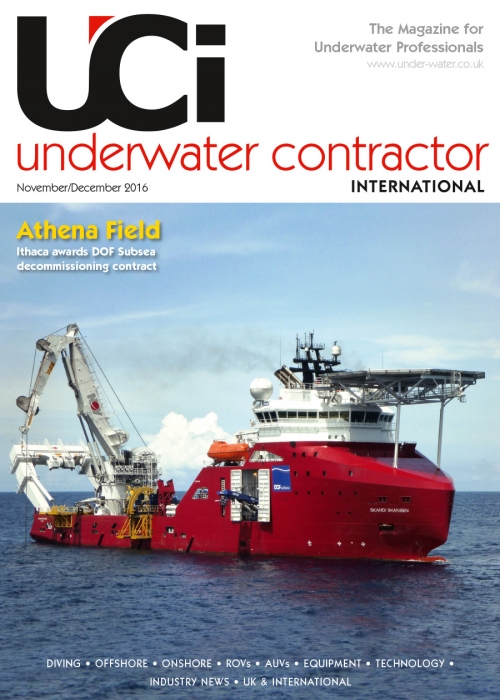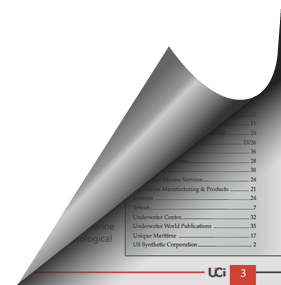
The Magazine for Underwater Professionals
![]() Nov/Dec 2015
Nov/Dec 2015
INDUSTRY NEWS - OPERATIONS
James Fisher completes subsea cable deployment at MeyGen
James Fisher and Sons, UK, has announced the successful deployment of the subsea export cables, as part of the initial construction phase (Phase 1A), in support of UK-based MeyGen Ltd’s ground-breaking 398-megawatt tidal array at Pentland Firth, Scotland.
Utilising specialist in-house expertise from a number of group companies, the integrated solution delivered significant cost benefits and operational efficiencies to MeyGen, through the combination of innovative products and services exclusive to James Fisher, according to a spokesman for the company.
Tim Cornelius, chief executive officer of the Atlantis Resources, UK, the majority owner of MeyGen, said: “This is an excellent result for the project. By its very nature, the offshore site is a challenging tidal environment and to complete the installation campaign safely and in line with the programme is a commendable achievement by our onshore and offshore teams, aided by great performance from the vessel. After all the planning it is very rewarding to see the offshore infrastructure taking shape for this trail-blazing project.”
The James Fisher spokesman said principal contractor James Fisher Marine Services (JFMS), UK, acted as the project interface for the installation of four subsea cables at the MeyGen tidal energy project, with Mojo Maritime, the UK-based marine management specialist, acting as the project lead which coordinated all offshore activities during operations.
APPLY
“Mojo was able to apply its innovative marine project planning system Mermaid (which precisely simulates marine operations against historical tidal data) to accurately optimise critical project operations and significantly reduce costs,” the spokesman said. “A short neap window was identified and in order to achieve it, the vessel would have to lay one cable every 12 hours. While ambitious, this schedule was achieved and the offshore operation took just two and a half days.”
Mobilisation was very compressed and required extensive input from all involved to mobilise an entire cable spread in four days, according to the spokesman. The Siem Daya 1 DP vessel was carefully selected on its capabilities, as Mojo understood that securely positioning the vessel within the extreme tidal conditions would be a critical factor in achieving success, he said.
Commenting on the project’s overall success, Richard Parkinson, managing director at Mojo, said: “Attention to detail and the safety of all personnel was paramount throughout every aspect of this project. Installing 11 kilometres of cable in tidal speeds of up to six knots posed significant challenges in planning and delivery and we knew we had a demanding schedule.
“It is a credit to the relentless effort of the team that we were able to achieve a safe and highly optimised cable pull and lay programme.”
Demonstrating the streamlined service delivery from James Fisher, further group company involvement included: James Fisher Subsea, UK, heading up the diving services and mobilisation of a full dive spread; James Fisher Offshore, UK, supplying marine equipment; and Fendercare Marine, UK, providing mooring systems.
Aberdeen, UK-based subsea IMR provider N-Sea Offshore Ltd reports it has successfully completed a fully integrated and managed service for Maersk Oil UK’s 2015 subsea inspection programme.
The work scope involved four field locations in the North Sea and utilised N-Sea’s IMR and subsea capabilities for a duration of 135 days.
The Siem N-Sea was utilised for the scope, to combine ROV inspection services with IMR diving works. The vessel is part of N-Sea’s fleet of dive, multi-support and construction vessels designed to deliver a range of subsea services for offshore assets, platforms, FPSOs and renewables operations.
N-Sea’s chief operating officer, Roddy James, said: “The successful completion of this contract further consolidates our excellent relationship with Maersk Oil, which has always been based upon trust and transparency. The project was completed efficiently and safely with no incidents, and reflected our ability to always provide safe, sound and swift solutions.
“At a time when identifying streamlined and cost effective solutions is crucial, combining ROV inspection services and IMR diving works into one work scope ensured this project delivered significant cost savings and achieved optimum efficiencies for the client.”
Ashtead Technology, the Aberdeen, UK-headquartered provider of subsea equipment rental, sales and services, reports it has been supporting attempts to explore the wreckage of the USS Macon, the United States Navy’s last flying airship.
Designed for long-range scouting, the airship crashed off the coast of California, USA, in 1935 when it was returning to the Moffett Federal Airfield following a successful exercise over the Channel Islands, Southern California. A storm caused extensive damage to the airship, control was lost and the USS Macon sank to the bottom of the Pacific Ocean.
The incident led to the death of two crew members and ended the Navy’s quest to use airships as long-range scouts for the fleet.
The recent expedition was led by archaeologists from the US National Oceanic and Atmospheric Administration (NOAA), the US Naval History and Heritage Command’s Underwater Archaeology Branch and the US Ocean Exploration Trust to piece together a clearer map of the wreck site and to study how the remains of the airship were being consumed by the sea.
STUDY
Ashtead provided subsea inspection equipment to study the wreckage and carry out in-depth corrosion analysis on the aircraft to monitor deterioration.
The specialist technology supplied by Ashtead included a Polatrak Deep C Meter 3000, which allowed researchers to measure the gradual corrosion of the aluminium materials and sample the conditions for metallurgical study.
The 12-hour expedition, which was broadcast live online, revealed that the wreckage is corroding faster than expected.
Chris Echols, vice president of Ashtead Technology in Houston, USA, said: “It’s been an honour to help answer some of the questions that have surrounded the tragedy and have been able to build up an accurate picture of the USS Macon and its current state.
“Earlier explorations of the site in 1991 and 2006 photographed and identified the engines, fuel tanks, ovens, tires and the four biplanes, all of which were still relatively intact, however with new advances in technology, we can help researchers delve deeper and gather more meaningful data from the site.
“They were able to gain a better understanding of how long the wreckage will remain intact and document exactly what they encountered at the bottom of the ocean.”
The exploration team used Ashtead’s Polatrak Deep C Meter alongside the Ocean Exploration Trust’s Nautilus ROV to take a 360-degree video of the site, assess corrosion and measure how much sediment had built up since 1935.
“The aim of the mission was to monitor and preserve the wreck site to the best of our ability. The remains of the USS Macon will continue to deteriorate, but we want to continue to document its condition now and into the future. We’re really extending the life of the airship and documenting the past 80 years she spent underwater, where the majority of her life has been spent,” said NOAA archaeologist Megan Lickliter-Mundon.
LEARN
She added: “We already had a good understanding of how materials from older shipwrecks – wood, iron, copper alloys – react to their underwater environment. However, with twentieth-century materials like aluminium alloys, we still haven’t quite figured out as a discipline how to best conserve the material, or how those materials react with their environment and with other materials. This was an opportunity to learn through the samples that we collected about the rate of corrosion and how to best help preserve them going forward.
“There are great environmental challenges associated at 1400 feet (427 metres) below the sea surface and without the help from Ashtead, we wouldn’t have been able to preserve and document artefacts for future generations.”


